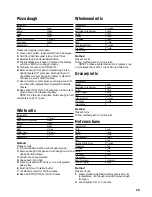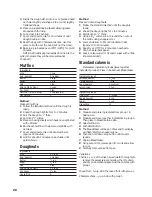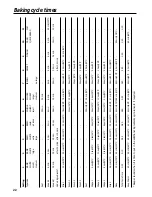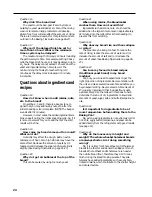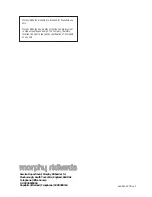
24
Question 16
Why didn't the bread rise?
The yeast could be bad, past it’s sell by date or
possibly no yeast was added at all. Also, if the mixing
was not complete, rising problems could develop.
Gluten free flour will also affect the amount of rising.
There are numerous reasons for this problem and are
outlined in the Baking Tips Guide on page 26-27).
Question 17
Why can't the delayed finish be set for
more than 12 hour? What is the minimum
time a cycle may be delayed?
The maximum length of delay is 12 hours including
the particular cycle time. For example, setting 3 has a
cycle that takes 3:25 hours, so it may be delayed up to
8
1/
2
hours. The delay cannot exceed 12 hours since the
yeast and ingredients may not work well. The
minimum length of delay for each setting is 10
minutes, as the delay clock increases in 10 minute
increments.
Questions about ingredients and
recipes
Question 18
How do I know when to add raisins, nuts,
etc. to the bread?
On setting 2, 3 and 8, there is a beeper tone to
signal that you may add raisins, nuts, etc. after the
initial kneading cycle is complete. (NOTE: The beeper
sounds after 32 minutes).
However, in most cases, the added ingredients are
broken apart during the initial kneading cycle. So, if it
is more convenient for you to add them at the start,
results will be fine.
Question 19
How come my bread comes out too moist?
What can I do?
Humidity may affect the dough. Add an extra
tablespoon of flour. Also, high altitude may have the
same effect. Decrease the amount of yeast by 1/4
teaspoon and decrease the sugar and/or water/milk
slightly. (See Baking Tips Guide on page 26-27).
Question 20
Why do I get air bubbles at the top of the
bread?
This can be caused by using too much yeast.
Question 21
When using raisins, the Breadmaker
crushes them. How can I avoid this?
Ingredients such as raisins, nuts, etc., should be
added when the signal time comes on approximately
32 minutes into the cycle (after initial kneading) to
prevent this from occurring.
Question 22
Why does my bread rise and then collapse
or crater?
The bread may be rising too fast. To reduce the
rate of rising, reduce the amount of water and / or
increase the amount of salt and / or decrease the
amount of yeast. (See Baking Tips Guide on page 26-
27).
Question 23
Can I use my favourite bread recipes
(traditional yeast bread) in my bread
machine?
Yes, but you will need to experiment to get the
right proportion of ingredients. Become familiar with
the unit and make several loaves of bread before you
begin experimenting. Never exceed a total amount of
5
1/
4
cups dry ingredients (that includes flours, oats,
oatmeal, bran). Use the recipes in this book to help
determine the ratio of dry ingredients to liquid and
amounts of yeast, sugar, salt, and butter/margarine to
use.
Question 24
Is it important for ingredients to be at
room temperature before adding them to the
Baking Pan?
No, as long as ingredients are not extremely cold or
hot. Milk, eggs, butter/margarine, and yeast can be
added directly from the refrigerator with good results
(see page 14).
Question 25
Why do the loaves vary in height and
weight? The whole wheat/wholemeal breads
are always shorter. Am I doing something
wrong?
No, it is normal for Whole Wheat and Wholemeal
breads to be shorter and denser than Basic or French
breads. Whole Wheat and Wholemeal are heavier
than white bread flour, therefore they don't rise as
much during the bread making process. They also
typically have added ingredients, such as oats, bran,
nuts and raisins, which contribute to the shorter height
and denser texture.










